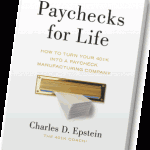Whether it is due to demographics or the dismal performance of the stock market or the weak economy, the focus on retirement income has never been greater.
So while much of the media’s attention is focused on the big picture, the bulk of Americans approaching and saving for retirement through their 401(k) plans have been left behind to fend for themselves.
Enter Charlie D. Epstein (no relation), who has developed a reputation as “the 401(k) Coach.” Charlie has a plan to make these individual 401(k) participants into entrepreneurs, at least as far as managing their own finances are concerned.
In his new book, Paychecks for Life, Charlie presents a number of real-life activities, which can help individuals increase their savings, optimize their 401(k) accounts so they do not turn into 201(k) s. As noted in his book, if applied correctly, his recommendations allow individuals to turn their 401(k) s into a steady income stream for life.

Of course, the size of that stream is determined by how diligent a person is in devising and following Charlie’s plan, which includes diligent savings, regular and steadily increasing contributions and essentially running your 401(k) plan like a business, with exacting attention to income, expenses and revenues. Over time, these recommendations can be converted into hundreds of thousands of dollars, which never would have existed before or been wasted.
Social Security: Don’t Count On It
One of Charlie’s key observations is that Social Security is a pay-as-you-go system, so it may not be around forever. But even when you receive the benefits, they alone will not be enough to improve anyone’s life style. That’s because Social Security benefits are determined by the last 35 years of earnings, plus the last three years of working. These amounts enter into the Social Security formula to determine benefit amounts. They are not determined by the taxes you paid into the system.
Similarly pension plans, like Social Security, are not legally binding agreements. They can be broken anytime, which is exactly what happened to pension plans since the late-1990s when about 25% were closed or frozen in 2007. This financial uncertainty puts more responsibility on individuals, not their employers, to achieve financial retirement security.
Charlie says this can be done by taking advantage of the benefits afforded in a 401(k): the employer’s matching contribution and the tax benefits offered by Uncle Sam. A cornerstone of Charlie’s strategy is to build a “paycheck manufacturing company” with the 401(k) plan as the main engine. The “employees” in your company are the actual dollars you contribute. The more dollars you contribute, the bigger your employee workforce. Even better, your money (employees) are working 24 hours a day, seven days a week for your benefit.
While people commonly complaint that they cannot save enough, even a small 1% incremental increase can translate into hundreds of thousands of dollars over decades. For example, an increase from a savings rate of 5% to 6% over time means the difference between having $500,000 and $650,000 at retirement.
While this is a staggering sum for many people, developing a disciplined savings plan is a staggering challenge to many people. But the good news is that people who bought a home, and have the discipline to meet mortgage payments easily paid that amount or more for a modest home purchase, if they included principal and interest payments over the life of their mortgage.
Charlie identifies this as the same discipline needed to save for retirement. He calls it the “desirement mortgage number,” which is the money you need in retirement to do everything you wanted to do, including meeting your daily expenses. The “desirement mortgage number” consists of your “down payment”: Social Security benefit plus your retirement savings. The difference between these two amounts and your “desirement mortgage” is what you need to save monthly to bridge that difference.
For example, a 35-year-old retiring at age 65 needs $1.2 million to generate paychecks for life. If they have earned Social Security life benefits totaling $241,000 and have retirement savings of $271,000 (comprised of a $45,000 401(k) earning a 6% annual return), they need to generate about $696,000 over 30 years to meet their goal. How to do this? Using an online calculator, a person needs to save $690 a month earning a 6% compounded return to hit the goal.
While this is a significant amount for any family to save, Charlie says it can be done incrementally by increasing a family’s savings rate by 1% annually until the target savings rate is reached. Following Charlie’s plan, savings, disciplined investing, and participating to the maximum in a 401(K) can work together to generate an individual’s desired retirement income.
The Importance of Reducing Plan Expenses
As the nation’s “401K Coach,” Charlie also focuses on reducing fund expenses, a move he called “very positive,” and how they benefit investors. Given the enactment of the DOL’s new fee disclosure rules this spring, Charlie estimated it could improve participant returns by at least 10 basis points. He also said there is a disconnect between the emphasis on meeting a plan sponsor’s fiduciary responsibilities and helping plan participants achieve their individual financial success.
He also noted that the U.S. Treasury is working to develop a formula to convert lump-sum 401(k) payments into lifetime checks. In essence, this would be a method of converting the assets of DC (defined contribution or 401(k) plans into the benefits formerly provided by DB (pension) plans. The development of this formula could occur within the next five to ten years, and it could essentially represent the “paychecks for life” that Charlie advocates in his practice.










